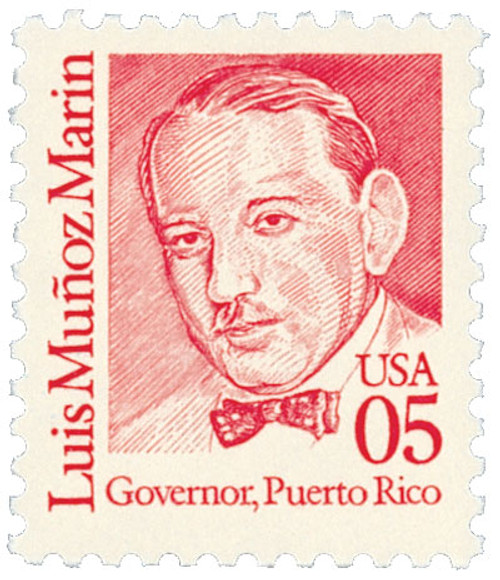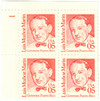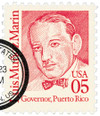
# 2173 - 1990 5c Great Americans: Luis Munoz Marin
U.S. #2173
1990 5¢ Luis Munoz Marin
Great Americans
- First Great Americans stamp with extra information about the honoree in the design and the selvage
- First stamp under 10¢ with a zero in front of the denomination
Stamp Category: Definitive
Series: Great Americans
Value: 5¢, used for make-up postage
First Day of Issue: February 18, 1990
First Day City: San Juan, Puerto Rico
Quantity Issued: 155,780,000
Printed by: Bureau of Engraving and printing
Printing Method: Engraved
Format: Panes of 100 in sheets of 800
Perforations: 11.2
Color: Carmine
Why the stamp was issued: This 5¢ stamp is what the USPS calls “change maker” postage. These stamps with denominations of 1¢ through 6¢ are produced to make up the wide variety of rates for third-class parcel post, which has many combinations of charges for weight and distance. These stamps were also useful when first-class rates went up, before the USPS could release stamps at the new rate.
This was also the second US stamp to honor Muñoz. A 1949 stamp (US #983) commemorated his election as Puerto Rico’s first governor.
About the stamp design: Puerto Rico native Juan Maldonado, who had already painted several portraits of Muñoz, was selected to design this stamp. He created his portrait based on two photos of Muñoz as a young man
Special design details: This stamp marked two firsts for the Great Americans Series. First, it was the first to include identifying information on the stamp. When the Great Americans Series was first begun, the USPS didn’t want to clutter the stamps with too much text, so the subjects were only identified by their names. However, over time, they received complaints that postal customers didn’t know who the people were, or why they deserved to be honored on a stamp. With this issue, the USPS changed that, and Marin is identified as “Governor, Puerto Rico.”
The other first for this stamp is the denomination expressed as “05.” Previous stamps in the series included a “c” after the denomination, or simply the number (ex: “5”). However, that created confusion, as some people tried to pass 1¢ stamps off as $1 stamps and so on. In order to keep the new stamps consistent, and not add to the clutter, all denominations under 10¢ would include a zero at the start, so the denominations could all uniformly be two characters wide.
First Day City: The First Day ceremony for this stamp was held in San Juan, Puerto Rico, on Muñoz’s 102nd birthday.
Unusual fact about this stamp: An error and unique feature of the Muñoz stamp came about due to a siderographer’s mistake. As a result, this stamp has the first combination ZIP/plate number block in US postal history. The lower-left and lower-right panes include both the sleeve number and “Use the Correct ZIP Code” in the corner selvage.
About the Great Americans Series: The Great Americans Series was created to replace the Americana Series. The new series would be characterized by a standard definitive size, simple design, and monochromatic colors.
This simple design included a portrait, “USA,” the denomination, the person’s name, and in some cases, their occupation or reason for recognition. The first stamp in the new series was issued on December 27, 1980. It honored Sequoyah and fulfilled the new international postcard rate that would go into effect in January 1981.
The Great Americans Series would honor a wider range of people than the previous Prominent Americans and Liberty Series. While those series mainly honored presidents and politicians, the Great Americans Series featured people from many fields and ethnicities. They were individuals who were leaders in education, the military, literature, the arts, and human and civil rights. Plus, while the previous series only honored a few women, the Great Americans featured 15 women. This was also the first definitive series to honor Native Americans, with five stamps.
The Bureau of Engraving and Printing (BEP) produced most of the stamps, but private firms printed some. Several stamps saw multiple printings. The result was many different varieties, with tagging being the key to understanding them. Though there were also differences in perforations, gum, paper, and ink color.
The final stamp in the series was issued on July 17, 1999, honoring Justin S. Morrill. Spanning 20 years, the Great Americans was the longest-running US definitive series. It was also the largest series of face-different stamps, with a total of 63.
Click here for all the individual stamps and click here for the complete series.
History the stamp represents: On January 2, 1949, Luis Muñoz Marín became Puerto Rico’s first independently-elected governor.
Puerto Rico had been governed by Spain for more than three centuries before it was annexed to the United States in 1898. For the next fifty years, its governor was appointed by America’s president. In 1946, President Harry S. Truman appointed the island’s first full-time Puerto Rican governor – Jesús T. Piñero.
However, twice previously a Puerto Rican had temporarily served as governor. The first time was in 1579, when Juan Ponce de León II, the grandson of explorer Ponce de León, served as interim governor until the arrival of Spanish Governor Jerónimo De Aguero Campuzano. Also, in 1923, Juan Bernardo Huyke temporarily held the position in between the administrations of Americans Emmet Montgomery Reily and Horace Mann Towner.
Then, in 1947, the United States Congress passed the Elective Governors Act, allowing Puerto Rico to elect its own governor. On November 2, 1947, the first elections for governor of Puerto Rico were held. Luis Muñoz Marín, a member of the Popular Democratic Party, emerged victorious, with 61.2% of the vote.
Marín first became involved in politics in the 1930s. As a member of the Puerto Rican Senate, he supported industrialization and agricultural reform. As president of the senate, Marín helped form Operation Bootstrap, which encouraged investment in manufacturing plants and job training for those in poverty. During his campaign for governor, Marín claimed, “Don’t trust politicians, even me. If you want to sell your vote, go ahead: it’s a free country. But make up your minds that you can’t have justice and the $2.00.”
On January 2, 1949, Marin was sworn in as Puerto Rico’s first independently elected governor, a position he held until 1965. Under his leadership, Puerto Rico was given greater autonomy from the US, and also adopted a constitution. After serving five terms, supporters wanted Muñoz Marín to run again. He declined, saying “I am not your strength… You are your own strength.” The former governor was praised by world leaders for the advances his country made under his leadership. Time magazine called Muñoz Marín “one of the most influential politicians in recent times, whose works will be remembered for years to come.”
Puerto Rico became a Commonwealth of the United States in 1952, and Congress approved the first Constitution of Puerto Rico. It listed rules on how Puerto Rico’s governors could be elected, including one that states if the margin of victory is less than half a percent, then a full recount must occur. This happened in 1980 and 2004.
Sila Calderón became the first woman to be elected governor of Puerto Rico when she won the 2000 election. She served from 2001-2005. Calderón previously served as mayor of San Juan from 1997-2001.
U.S. #2173
1990 5¢ Luis Munoz Marin
Great Americans
- First Great Americans stamp with extra information about the honoree in the design and the selvage
- First stamp under 10¢ with a zero in front of the denomination
Stamp Category: Definitive
Series: Great Americans
Value: 5¢, used for make-up postage
First Day of Issue: February 18, 1990
First Day City: San Juan, Puerto Rico
Quantity Issued: 155,780,000
Printed by: Bureau of Engraving and printing
Printing Method: Engraved
Format: Panes of 100 in sheets of 800
Perforations: 11.2
Color: Carmine
Why the stamp was issued: This 5¢ stamp is what the USPS calls “change maker” postage. These stamps with denominations of 1¢ through 6¢ are produced to make up the wide variety of rates for third-class parcel post, which has many combinations of charges for weight and distance. These stamps were also useful when first-class rates went up, before the USPS could release stamps at the new rate.
This was also the second US stamp to honor Muñoz. A 1949 stamp (US #983) commemorated his election as Puerto Rico’s first governor.
About the stamp design: Puerto Rico native Juan Maldonado, who had already painted several portraits of Muñoz, was selected to design this stamp. He created his portrait based on two photos of Muñoz as a young man
Special design details: This stamp marked two firsts for the Great Americans Series. First, it was the first to include identifying information on the stamp. When the Great Americans Series was first begun, the USPS didn’t want to clutter the stamps with too much text, so the subjects were only identified by their names. However, over time, they received complaints that postal customers didn’t know who the people were, or why they deserved to be honored on a stamp. With this issue, the USPS changed that, and Marin is identified as “Governor, Puerto Rico.”
The other first for this stamp is the denomination expressed as “05.” Previous stamps in the series included a “c” after the denomination, or simply the number (ex: “5”). However, that created confusion, as some people tried to pass 1¢ stamps off as $1 stamps and so on. In order to keep the new stamps consistent, and not add to the clutter, all denominations under 10¢ would include a zero at the start, so the denominations could all uniformly be two characters wide.
First Day City: The First Day ceremony for this stamp was held in San Juan, Puerto Rico, on Muñoz’s 102nd birthday.
Unusual fact about this stamp: An error and unique feature of the Muñoz stamp came about due to a siderographer’s mistake. As a result, this stamp has the first combination ZIP/plate number block in US postal history. The lower-left and lower-right panes include both the sleeve number and “Use the Correct ZIP Code” in the corner selvage.
About the Great Americans Series: The Great Americans Series was created to replace the Americana Series. The new series would be characterized by a standard definitive size, simple design, and monochromatic colors.
This simple design included a portrait, “USA,” the denomination, the person’s name, and in some cases, their occupation or reason for recognition. The first stamp in the new series was issued on December 27, 1980. It honored Sequoyah and fulfilled the new international postcard rate that would go into effect in January 1981.
The Great Americans Series would honor a wider range of people than the previous Prominent Americans and Liberty Series. While those series mainly honored presidents and politicians, the Great Americans Series featured people from many fields and ethnicities. They were individuals who were leaders in education, the military, literature, the arts, and human and civil rights. Plus, while the previous series only honored a few women, the Great Americans featured 15 women. This was also the first definitive series to honor Native Americans, with five stamps.
The Bureau of Engraving and Printing (BEP) produced most of the stamps, but private firms printed some. Several stamps saw multiple printings. The result was many different varieties, with tagging being the key to understanding them. Though there were also differences in perforations, gum, paper, and ink color.
The final stamp in the series was issued on July 17, 1999, honoring Justin S. Morrill. Spanning 20 years, the Great Americans was the longest-running US definitive series. It was also the largest series of face-different stamps, with a total of 63.
Click here for all the individual stamps and click here for the complete series.
History the stamp represents: On January 2, 1949, Luis Muñoz Marín became Puerto Rico’s first independently-elected governor.
Puerto Rico had been governed by Spain for more than three centuries before it was annexed to the United States in 1898. For the next fifty years, its governor was appointed by America’s president. In 1946, President Harry S. Truman appointed the island’s first full-time Puerto Rican governor – Jesús T. Piñero.
However, twice previously a Puerto Rican had temporarily served as governor. The first time was in 1579, when Juan Ponce de León II, the grandson of explorer Ponce de León, served as interim governor until the arrival of Spanish Governor Jerónimo De Aguero Campuzano. Also, in 1923, Juan Bernardo Huyke temporarily held the position in between the administrations of Americans Emmet Montgomery Reily and Horace Mann Towner.
Then, in 1947, the United States Congress passed the Elective Governors Act, allowing Puerto Rico to elect its own governor. On November 2, 1947, the first elections for governor of Puerto Rico were held. Luis Muñoz Marín, a member of the Popular Democratic Party, emerged victorious, with 61.2% of the vote.
Marín first became involved in politics in the 1930s. As a member of the Puerto Rican Senate, he supported industrialization and agricultural reform. As president of the senate, Marín helped form Operation Bootstrap, which encouraged investment in manufacturing plants and job training for those in poverty. During his campaign for governor, Marín claimed, “Don’t trust politicians, even me. If you want to sell your vote, go ahead: it’s a free country. But make up your minds that you can’t have justice and the $2.00.”
On January 2, 1949, Marin was sworn in as Puerto Rico’s first independently elected governor, a position he held until 1965. Under his leadership, Puerto Rico was given greater autonomy from the US, and also adopted a constitution. After serving five terms, supporters wanted Muñoz Marín to run again. He declined, saying “I am not your strength… You are your own strength.” The former governor was praised by world leaders for the advances his country made under his leadership. Time magazine called Muñoz Marín “one of the most influential politicians in recent times, whose works will be remembered for years to come.”
Puerto Rico became a Commonwealth of the United States in 1952, and Congress approved the first Constitution of Puerto Rico. It listed rules on how Puerto Rico’s governors could be elected, including one that states if the margin of victory is less than half a percent, then a full recount must occur. This happened in 1980 and 2004.
Sila Calderón became the first woman to be elected governor of Puerto Rico when she won the 2000 election. She served from 2001-2005. Calderón previously served as mayor of San Juan from 1997-2001.





















